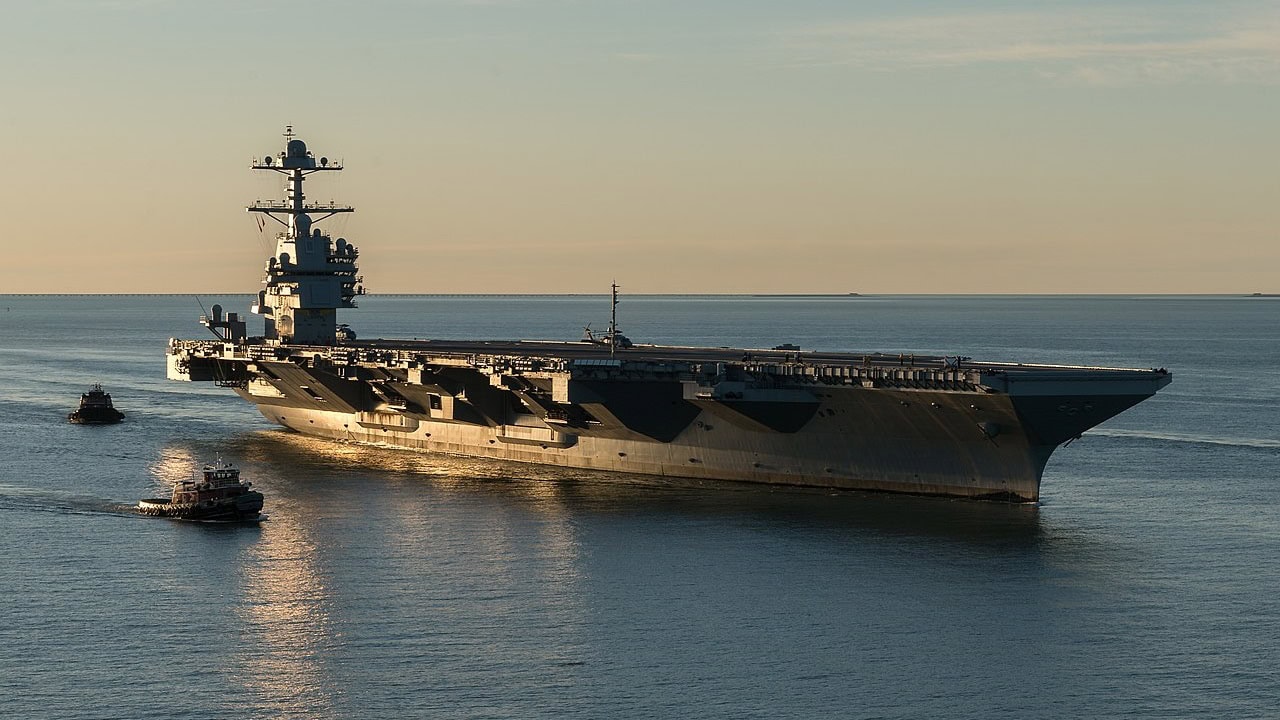The U.S. Navy has been committed for decades to building evermore advanced aircraft carriers that are nuclear-powered – like the Ford-Class. But with the rise of missiles that can be fired from thousands of miles away that could, at least in theory, sink those warships, isn’t it time for the Navy to consider other options? China and Russia would at least like us to think so:
Recently, the United States Navy’s newest aircraft carrier, USS Gerald R. Ford (CVN-78) – the lead vessel of a new class of nuclear-powered supercarriers – just completed a Combat Systems Operational Readiness Exercise (CSORE), marking a crucial turning point in the ship’s deployment readiness. The exercise was meant to check the functionality of combat systems and to further test the crew’s ability to handle threats to the ship. The flattop is inching closer to her maiden deployment, which is scheduled for later this year.
As the largest warship ever constructed in terms of displacement, CVN-78 is an impressive vessel that will likely serve as a power projection throughout the world for decades to come. Yet, the vessel is also several years late, and at $13.3 billion total is also the most expensive warship ever built.
Simply put, the USS Gerald R. Ford is the worst carrier ever built by the United States Navy. Though she is loaded with new and innovative technologies, the issue is that numerous systems haven’t worked as planned. From the ship’s toilets, which regularly clog, to the ordnance elevators that didn’t function properly; numerous systems have had serious teething issues that have needed to be resolved.
Another concern is that a supercarrier is really a big target. The old fear was from enemy aircraft and submarines, but the threat now includes hypersonic missiles, undersea unmanned vehicles (UUVs), and unmanned aerial vehicles (UAVs). Low tech threats still remain a concern as well, as was seen on October 12, 2000, when suicide terrorists exploded a small boat alongside the USS Cole.
It wouldn’t really take all that much to do considerable damage to such a high-value target.
In addition, the systems are now so complex that they could even be targeted in a cyber attack. The question is whether the United States Navy needs such a massive floating airbase that faces so many threats.
Ford-Class: Replacement Cycle
The biggest argument against a nuclear-powered carrier is that it really isn’t an efficient system. Yes, such a vessel has nearly unlimited range, yet the endurance is only as great as the food and water it can carry. A ship that can stay at sea indefinitely is good until one considers that it still needs to be supplied with fuel for the aircraft and food for the crew.
During the global Covid-19 pandemic, USS Nimitz (CVN-68) completed the longest deployment of a carrier since the Vietnam War, spending 321 days at sea. It was hardly good for the crew, who had to endure 10 months at sea, but it also pushed the ship hard and required a lengthy maintenance period. Even worse, the Nimitz-class carrier USS Theodore Roosevelt (CVN-71) was sidelined for months due to an outbreak of Covid. Massive vessels that have such massive crews could be at risk during another pandemic.
Then there is the fact that even the regular maintenance of these supercarriers takes months and there is little indication that this will be improved on CVN-78 or the other Gerald R. Ford-class flattops. Moreover, the mid-life refueling of the nuclear reactors takes the ships out of service for years! The United States Navy may have 11 nuclear-powered carriers in its fleet, but rarely are more than five or six deployed at any one time.
Life Cycle Woes
Yet, the biggest consideration on why these new supercarriers are just a bad idea is that there seems to be little planning for their end of life. Even as the cost to construct the next ships in the class has fallen, there are the billions of dollars that the Navy will have to pay to eventually dispose of these vessels. It was reported that it could take more than a decade and a half to fully dismantle and scrap USS Enterprise (CVN-65), the first nuclear-powered aircraft carrier, while the price tag could be more than $1.5 billion!
Even once the issues with CVN-65 are addressed, the Navy will have to deal with the Nimitz-class carriers that the new Ford-class will be replaced on a one-for-one basis. This issue isn’t likely to get better with the newest carriers being built.
Each may be impressive, but the Gerald R. Ford-class carriers take years to build, cost a not-so-small fortune, require massive maintenance, and will take years to dismantle. Perhaps it would be wiser to update the conventionally powered Kitty Hawk-class and complement them with more America-class amphibious assault ships (LHDs), which would be better suited to a potential war in the Indo-Pacific. Each of those flattops would be cheaper to build, we could build more of them, and they’d be easier to retire when the time comes. And they aren’t a nuclear disaster waiting to happen should a terrorist get lucky.
Expert Biography: A Senior Editor for 1945, Peter Suciu is a Michigan-based writer who has contributed to more than four dozen magazines, newspapers, and websites with over 3,000 published pieces over a twenty-year career in journalism. He regularly writes about military hardware, firearms history, cybersecurity, and international affairs. Peter is also a Contributing Writer for Forbes.

